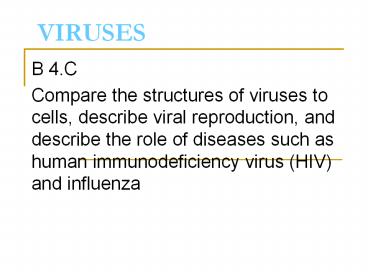VIRUSES - PowerPoint PPT Presentation
Title:
VIRUSES
Description:
VIRUSES B 4.C Compare the structures of viruses to cells, describe viral reproduction, and describe the role of diseases such as human immunodeficiency virus (HIV ... – PowerPoint PPT presentation
Number of Views:560
Avg rating:3.0/5.0
Title: VIRUSES
1
VIRUSES
- B 4.C
- Compare the structures of viruses to cells,
describe viral reproduction, and describe the
role of diseases such as human immunodeficiency
virus (HIV) and influenza
2
Videos Viral invasion of the body
Part 1
- http//www.youtube.com/watch?vD2Uuc76DvlIfeature
youtu.be - http//www.youtube.com/watch?vsoIDiqxtTjMfeature
youtu.be
Part 2
3
What is a Virus?
- Much smaller than cells
- A NON-LIVING infectious agent made up of a core
of DNA or RNA surrounded by a protein coat. - Viruses need host cells to replicate the viral
DNA. They enter a living host cell and hijack it
to produce more viruses - Viruses eventually kill their host cells
(Reproduce)
4
Parts of a Virus
- Capsid Protein coat
- Genetic core DNA or RNA
- IS NOT LIVING!!!!!!!
- IS NOT A CELL!!!!!!!
- DOES NOT have organelles!!!!
5
Protein Coat (part that hold the DNA)
Legs (anchor the virus to the cell)
6
A cure for viruses?
- No said cure for a virus, only preventions
- Vaccine weakened or deadened form of a virus
- Viruses cannot be destroyed by antibiotics!!!!
- Antibiotics are for bacteria not viruses!
7
We Classify Viruses by
- Shape (what they look like)
- Host (the type of cell they infect)
- Function (how they infect cells)
- Genetic Core (DNA or RNA)
8
Viral Shapes
Shape
Helical
Enveloped
Binal
Examples
Tobacco Mosaic Virus
Influenza Virus
T4 Bacteriophage
9
CAPSID
WEST NILE VIRUS
HERPES
SARS
10
HEPATITIS B
BIRD FLU
11
One Type of Viral Replication
- Virus attaches to host cell
- Virus injects DNA or RNA into cell
- Viral DNA or RNA is replicated or
reverse-transcribed - Transcription and Translation takes place to make
capsid - Cell assembles viruses
- Cell is lysed, new viruses are released and
infect other cells
12
Cell Virus
13
Viruses that affect humans
- Influenza (the flu)
- HIV
- Chicken pox Shingles
- Herpes
- Common colds
- Epstein Barr
- HPV
- Rabies
- Measles
- Mumps
- Rubella
- Polio
- West Nile
- Hepatitis A, B, C
- Ebola
- Small pox
14
Human Immunodeficiency Virus
- HIV causes AIDS
- HIV attacks Helper T-Cells, which are vital to
our immune system - Since HIV decreases the immune system, a person
is more prone to secondary infections than a
normal person
Mutates too quickly to make a vaccine
15
InFLUenza
- Symptoms High fever, sore throat, fatigue,
aches, coughs - Mutates regularly. That is why we have vaccines
yearly - Can be air borne - When some one coughs or
sneezes, you can contract the virus by breathing
it in.
What shape are these viruses?
16
SARS
- Severe acute respiratory syndrome
- Airborne- can be transmitted when an infected
person coughs or sneezes.
17
Common Colds
- Upper respiratory infections (nose, throat,
lungs) - Usually clear up in 2 weeks without complications
- More than 200 known viruses can cause colds
18
Small pox
- Virtually eradicated!
- Only found in 2 labs on Earth Russia and US
- Small pox vaccine was made from cowpox
- Symptoms
- High fever, aches, rashes
19
Human Papilloma Virus (HPV)
- Affects both men and women
- Sexually transmitted
- Can cause cervical cancer
- Gardasil vaccine that may prevent cervical
cancer
20
Herpesvirus
- Chicken Pox
- Fever
- Incubation of 14 days
- Red itchy rash
- Vaccination available
- Other herpesviruses include Herpes (cold sores
and genital herpes)
21
Measles
- High fever
- Sore throat, cough, sneezing
- Rash
- Dangerous for pregnant women
- You received a vaccine for MMR (measles, mumps,
rubella)
22
Polio
- Symptoms Fever, headache, muscle weakness,
difficulty swallowing - Hundreds of thousands affected until vaccination
became available
Franklin D. Roosevelt, President from 1932 to
1945
23
Ebola
- 1977 Ebola Zaire (picture)
- Named after the Ebola River in Zaire
- High hemorrhagic fever
- High death rate
24
(No Transcript)
25
(No Transcript)
26
Viruses vs. Cells































